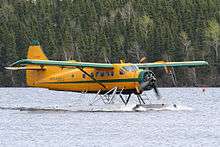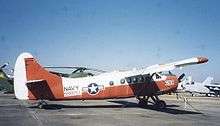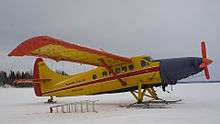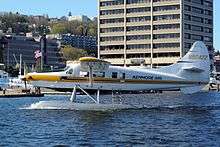de Havilland Canada DHC-3 Otter
| DHC-3 Otter | |
|---|---|
| | |
| Turbine Otter in Kenmore Air livery | |
| Role | STOL utility transport |
| Manufacturer | de Havilland Canada |
| First flight | 12 December 1951 |
| Introduction | 1953 |
| Status | Active |
| Produced | 1951–1967 |
| Number built | 466 |
| Developed from | DHC-2 Beaver |
| Developed into | DHC-6 Twin Otter |
The de Havilland Canada DHC-3 Otter is a single-engined, high-wing, propeller-driven, short take-off and landing (STOL) aircraft developed by de Havilland Canada. It was conceived to be capable of performing the same roles as the earlier and highly successful Beaver, but is overall a larger aircraft.
Design and development
When de Havilland Canada began design work on the "King Beaver" (the Otter's original name) in January 1951, it was trying to extend the company's line of rugged STOL utility transports that had begun with the Beaver. The single-engined, high-wing, propeller-driven DHC-3 Otter was conceived to be capable of performing the same roles as the Beaver, but was considerably larger, the veritable "one-ton truck" (in company parlance, the Beaver was the "half-ton truck").[1] Using the same overall configuration as the earlier and highly successful DHC2 Beaver, the new design incorporates a longer fuselage, greater-span wings, a cruciform tail, and is much heavier. Seating in the main cabin is for 10 or 11, whereas the Beaver can seat six. Power is supplied by a 450-kW (600 hp) Pratt & Whitney R-1340 geared radial. The version used in the Otter was geared for lower propeller revolutions and consequently lower airspeed. The electrical system was 28 volts D.C. Like the Beaver, the Otter can be fitted with skis or floats. The Otter served as the basis for the very successful Twin Otter, which features two wing-mounted Pratt & Whitney Canada PT6 turboprops.
The Otter received Canadian certification in November 1952 and entered production shortly thereafter. A total of 466 were manufactured.[2]
Operational use





The DHC-3/CC-123/CSR-123 Otter was used until 1980 by the Royal Canadian Air Force and its successor, the Air Command of the Canadian Forces. It was used in Search and Rescue, as the "CSR" denotes Canadian Search (and) Rescue (type 123) and as a light utility transport, "CC" denoting Canadian Cargo. During the Suez Crisis, the Canadian government decided to provide assistance to the United Nations Emergency Force and the Royal Canadian Navy carrier HMCS Magnificent carried 4 Otters from Halifax to Port Said in Egypt early in 1957, with all four flying off unassisted while the ship was at anchor.[3] This was the only occasion when RCAF fixed wing aircraft operated from a Canadian warship.[3] It was also operated on EDO floats on water and skis for winter operations on snow. The EDO floats also had wheels for use on runways (amphibious). It was used as army support dropping supplies by parachute, and also non-parachute low-speed, low-altitude air drops, to support the Canadian Army on maneuvers. In the end it was operated by the Primary Air Reserve in Montreal, Toronto, Edmonton and Winnipeg, with approximately 10 aircraft at each base, as well as by the RSU (Regular (Forces) Support Units) at those bases. It was usually flown with a single pilot (Commissioned Officer) in the left seat and a Technical Air Crewman (NCO) in the right seat. The Kiowa helicopter replaced it in Air Reserve squadrons.
Although the Otter found ready acceptance in bush airlines, as in a similar scenario to the DHC-2 Beaver, the United States Army soon became the largest operator of the aircraft (184 delivered as the U-1A Otter). Other military users included Australia, Canada, and India, but the primary role of the aircraft as a rugged bush plane continues to this day.
An Otter crossed the South Pole in 1957 (see Commonwealth Trans-Antarctic Expedition). The Otter is also popular in the skydiving community and can be found in many dropzones throughout the world.
Modifications
Stolairus Aviation of Kelowna, BC, has developed several modifications for the DHC-3 including a STOL Kit, which modifies the wing with a contoured leading edge and drooped wingtips for increased performance. Stolairus has also developed a 400 lb "upgross" kit which increases the gross weight of the DHC-3 to 8,367 lbs on floats.[4]
Some aircraft were converted to turbine power using a PT6A, Walter 601 (manufactured in the Czech Republic), or Garrett/Honeywell TPE331-10, by Texas Turbine Conversions. The Walter M601E-11 Turbine Engine conversion is manufactured and installed by Stolairus Aviation.
A Polish Pezetel radial engine has also been fitted. Re-engined aircraft have been offered since the 1980s by Airtech Canada as the DHC-3/1000 using current-production 1,000 hp (745 kW) PZL ASz-62 IR radials.[5]
Variants
- DHC-3 Otter
- Single-engined STOL utility transport aircraft.
- CSR-123 Otter
- STOL utility transport aircraft for the Royal Canadian Air Force.
- YU-1 Otter
- Six test and evaluation aircraft for the U.S. Army.
- U-1A Otter
- STOL utility transport aircraft for the US Army.
- UC-1 Otter
- STOL utility transport aircraft for the United States Navy. Later redesignated U-1B Otter in 1962.
- DHC-3-T Turbo-Otter
- Otters fitted with either Pratt & Whitney Canada PT6A-27 or Pratt & Whitney Canada PT6A-34 turboprop engine.
- Airtech Canada DHC-3/1000 Otter
- Conversions powered by PZL Kalisz ASz-62IR engines.
Military operators
- Argentine Air Force: Former operator
- Royal Australian Air Force: Two Otters (RAAF serial A100-1 and 2) were in service with the RAAF from 1961 to 1967. The aircraft were used for passenger and freight transport duties at the Weapons Research Establishment, Woomera, South Australia.
- No. 1 Air Trials Unit
- Bangladesh Air Force: Former operator
- Khmer Air Force: Former operator
- Paraguayan Air Force: One DHC-3 donated by Argentina.
- United States Air Force
- United States Army
- United States Navy
- Otter NU-1B is the oldest aircraft in the U.S. Navy, in service at the U.S. Naval Test Pilot School, Patuxent River, Md.[6]
Civil operators

http://www.vancouverislandair.com * Vancouver Island Air
- Volcanic Air (Rotorua)
Accidents
- On 22 June 1994, a float equipped Dehavilland, DHC-3 Otter, N13GA, registered to and operated by Wings of Alaska, of Juneau, Alaska, crashed into the Taku Inlet, 12 miles east of Juneau. The Air Taxi flight, operating under 14 CFR Part 135 by a Commercial Certificated pilot, last departed the Taku Lodge located on the Taku River, and the destination was the Juneau downtown dock. Instrument meteorological conditions prevailed at the time of the accident and a company flight plan was in effect. The airplane received substantial damage. Six passengers received fatal injuries, one passenger is missing and presumed dead, and the pilot and three passengers received serious injuries.[7]
- On 9 August 2010, a DHC-3T registered to Anchorage-based GCI crashed about 17 miles (27 km) north of Dillingham, Alaska, while en route to a private fishing lodge.[8] Five of the nine people on board were killed, including former Alaska Senator Ted Stevens. Surviving passengers included former NASA administrator Sean O'Keefe and his teenage son, both of whom sustained injuries.[9]
- On 23 September 2011, a single-engined, turbine-powered, amphibious float-equipped de Havilland DHC-3T airplane, N361TT, sustained substantial damage during a go-around and subsequent low-altitude maneuver at Heitman Lake, about 5 miles south-southwest of Kodiak, Alaska. The airplane was being operated by Paklook Air Inc., Kodiak, as a visual flight rules (VFR) on-demand air taxi flight, when the accident occurred. Of the three people aboard, the commercial pilot sustained fatal injuries, one passenger received serious injuries, and the remaining passenger received minor injuries. Visual meteorological conditions prevailed, and company-flight following procedures were in effect. The airplane departed Old Harbor, Alaska, bound for Kodiak. A passenger on the airplane reported that during a go-around on a lake, the airplane struck a tree on the shoreline and crashed. The passenger was able to make a cellphone call, and report the accident to authorities.[10]
- On 7 July 2013, a De Havilland Otter registered to Rediske Air of Nikiski crashed at Soldotna Airport, killing all 10 aboard.[11]
- On 25 June 2015, a Promech Air DHC-3 Otter crashed into the face of a granite cliff near Ella Lake, Alaska, 20 miles (32 km) northeast of Ketchikan. The aircraft carried a pilot and eight passengers who were tourists on a sightseeing excursion from a Holland America Line coastal cruise aboard the cruise ship MS Westerdam. All nine people on board died. The NTSB determined that the pilot had a history of poor decision making and that the company had a compromised culture that resulted in an "operation in which safety competed with performance and revenue".[12][13][14][15]
- On 15 September 2015, Federal Aviation Administration says a De Havilland DHC-3 Turbine Otter on floats carrying 10 people and belonging to Rainbow King Lodge crashed on takeoff at Eastwind Lake, 1 mile north of Iliamna, which is 175 miles SW of Anchorage. Three people were killed in the crash.[16]
Specifications (landplane)
Data from Jane's Civil and Military Aircraft Upgrades 1994–95[17]
General characteristics
- Crew: 1
- Capacity: 9 -10 passengers
- Length: 41 ft 10 in (12.80 m)
- Wingspan: 58 ft 0 in (17.69 m)
- Height: 12 ft 7 in (3.83 m)
- Wing area: 375 sq ft (34.84 m²)
- Empty weight: 4,431 lb (2,010 kg)
- Max. takeoff weight: 8,000 lb (3,629 kg)
- Powerplant: 1 × Pratt & Whitney R-1340-S1H1-G Wasp 9-cylinder air-cooled radial engine, 600 hp (448 kW)
Performance
- Maximum speed: 160 mph (139 knots, 257 km/h)
- Cruise speed: 121 mph (105 knots, 195 km/h) at sea level (econ cruise)
- Stall speed: 58 mph (50 knots, 93 km/h)
- Range: 945 mi (822 nmi, 1,520 km)
- Service ceiling: 18,800 ft (5,730 m)
- Rate of climb: 850 ft/min (4.3 m/s)
See also
- Related development
- Aircraft of comparable role, configuration and era
- Related lists
References
- Notes
- ↑ Rossiter 1998, p. 55.
- ↑ "The De Havilland DHC-3 Otter; a comprehensive information resource". dhc3otter.com. Retrieved July 5, 2017.
- 1 2 "The Otters and the aircraft carrier". lookoutnewspaper.com. July 22, 2013. Retrieved July 5, 2017.
- ↑ "DHC-3 Otter." Stolairus, Retrieved: February 2, 2012.
- ↑ Taylor 1988 p. 17.
- ↑ Naval Air Systems Command. "Photo of the NU-1B with the F-35B at NAS Patuxent River."
- ↑ "National Transportation Safety Board Aviation Accident Final Report Accident Number: ANC94FA070". National Transportation Safety Board. June 5, 1995. Retrieved July 5, 2017.
- ↑ Trimble, Stephen. "EADS executive survives Alaska air crash, but former senator killed." flightglobal.com, 10 August 2010. Retrieved: 10 August 2010.
- ↑ Bohrer, Becky. "Plane crashes in Alaska kills former Alaska Sen. Ted Stevens, ex-NASA chief survives." The Associated Press. via 680news.com, 10 August 2010. Retrieved: 10 August 2010.
- ↑ "National Transportation Safety Board Aviation Accident Final Report Accident Number: ANC11FA107". National Transportation Safety Board. February 27, 2013. Retrieved July 5, 2017.
- ↑ 10 killed in Soldotna plane crash, Peninsula Courier, 7 July 2013. Retrieved 7 July 2013.
- ↑ St. Claire, Pat (June 25, 2015). "Small plane carrying cruise passengers crashes in Alaska". CNN. Retrieved July 5, 2017.
- ↑ Morrison, Greg; Payne, Ed (June 30, 2015). "Authorities identify 9 people killed in Alaska plane crash". CNN. Retrieved July 5, 2017.
- ↑ Varandani, Suman, "Alaska Plane Crash: 9 People Killed After Sightseeing Plane Carrying Cruise Ship Passengers Crashes," ibtimes.com, June 26, 2015, 12:27 AM EDT.
- ↑ Grady, Mary (25 April 2017). "NTSB Cites “Company Culture” In Fatal Crash". AVweb. Retrieved 26 April 2017.
- ↑ D'Oro, Rachel (September 15, 2015). "Fishing lodge's floatplane crashes in Alaska; 3 dead, 7 hurt". Associated Press. Retrieved July 5, 2017.
- ↑ Michell 1994, p.24.
- Bibliography
- Hayes, Karl E. DHC-3 Otter - A History (CD-ROM). Crakaig, Killiney Hill Road, Killiney, Co. Dublin, Ireland: Karl E. Hayes Publisher, 2006. (also available via CANAV Books, Toronto)
- Hotson, Fred W. The de Havilland Canada Story. Toronto: CANAV Books, 1983. ISBN 0-07-549483-3.
- Michell, Simon. (ed.). Jane's Civil and Military Aircraft Upgrades 1994-95. Coulsdon, UK: Jane's Information Group, 1994. ISBN 0-7106-1208-7.
- Milberry, Larry. Aviation In Canada. Toronto: McGraw-Hill Ryerson Ltd., 1979. ISBN 0-07-082778-8.
- Molson, Ken M. and Harold A. Taylor. Canadian Aircraft Since 1909. Stittsville, Ontario: Canada's Wings, Inc., 1982. ISBN 0-920002-11-0.
- Rossiter, Sean. The Immortal Beaver: The World's Greatest Bush Plane. Vancouver: Douglas & McIntyre, 1999. ISBN 1-55054-724-0.
- Rossiter, Sean. Otter & Twin Otter: The Universal Airplanes. Vancouver: Douglas & McIntyre, 1998. ISBN 1-55054-637-6.
- Taylor, John W.R., ed. Jane's All The World's Aircraft 1988-89. Coulsdon, UK: Jane's Defence Data, 1988. ISBN 0-7106-0867-5.
External links
| Wikimedia Commons has media related to De Havilland Canada DHC-3 Otter. |
- www.DHC-3archive.com is a website recording the history of each of the 466 de Havilland Canada DHC-3 Otter aircraft produced.
- de Havilland Canada DHC-3 CC-123 Otter
- De Havilland Canada D.H.C.3 'Otter'
- US Navy Otter service in Antarctica